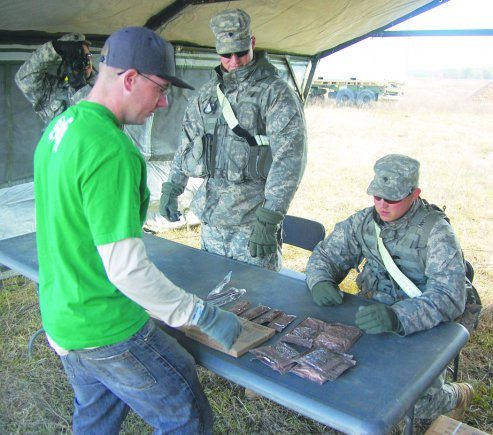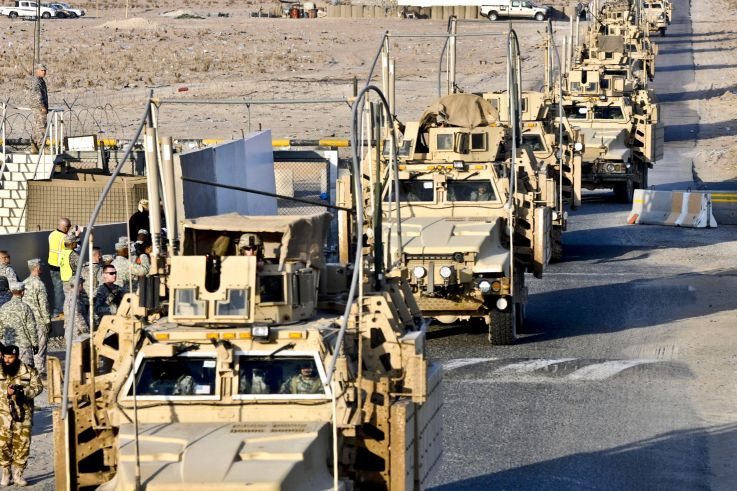Before taking on the role of the Army’s lead element in the Defense Chemical, Biological, Radiological and Nuclear Response Force, or DCRF, on Sept. 30, Fort Polk’s 1st Maneuver Enhancement Brigade took part in a training exercise at Camp Atterbury, Ind.
During the 1st MEB’s transfer of authority ceremony, Joint Readiness Training Center and Fort Polk commander Brig. Gen. Clarence K. K. Chinn, said the unit’s Soldiers were the best trained fighting force in the world and the best trained when it came to the DCRF mission.
“Our nation can sleep soundly at night knowing that in the event of a natural disaster or chemical, biological, radiological or nuclear incident, the 1st MEB is fully prepared and trained to deploy on a moment’s notice anywhere in the nation,” Chinn said.
The DCRF mission includes taking command of Task Force Operations. TF-OPS must be ready to deploy forces within 24 hours upon receipt of orders to respond to a crisis. Its mission is to deploy forces in support of DCRF to save lives and minimize human suffering, while under the Operational Control of Joint Task Force-Civil Support, or JTF-CS, by providing support to civil authorities, protecting personnel and providing a corridor of relief to restore the Joint Operations Area to operational levels.
JTF-CS, a subordinate command of United States Northern Command and headquartered at Fort Eustis, Va., provides command and control for Department of Defense forces deployed in support of the National Response plan, specifically managing the consequences of a domestic chemical, biologial, radiological, nuclear and high-yield explosive situation or natural disaster. Its activation is prompted by a request for support from civil leaders.
The 1st MEB had an opportunity to corroborate Chinn’s statement, and justify the Army’s confidence in its ability, during an exercise Dec. 4-9 that tested the force’s ability to deploy on a short time-line and handle a plethora of problems, including crowd control, debris removal, life-saving operations and humanitarian assistance.
“For our Soldiers, it allows us to lay out and practice the things we didn’t get to do at Camp Atterbury, Indiana, like how we move, how we move our vehicles, equipment and systems,” said Col. David T. Theisen, commander, 1st MEB. “It gives the Soldiers confidence and gets them comfortable with the systems they’ll be using. Plus, it’s great training.”
The training scenario revolved around an earthquake striking near Memphis, Tenn., along the New Madrid fault line that traverses the mid-section of the U.S. The exercise began with Soldiers moving vehicles to Fort Polk’s rail yard Dec. 4 to prep for movement to the Memphis area. Vehicles were prepped for loading onto rail cars.
After rail operations were complete, Soldiers and equipment moved out Dec. 5 to set up unit tactical operations centers and make contact with local civilian leaders to determine what help was needed. The unit used villages in Fort Polk’s training area, which are normally designed to replicate towns in Afghanistan and Iraq, to simulate portions of Memphis and nearby towns.
Among the 1st MEB units tasked with various missions was the 204th Military Police Company, 519th Military Police Battalion. The MPs found themselves conducting convoy security, humanitarian assistance, crowd control and mass casualty triage during the week-long exercise.
Capt. Curtis Allen, commander, 204th MP Co, said it was hard not to be happy with his Soldiers’ efforts.
“It’s all about building on what we’ve learned,” Allen said. “There are a lot of lessons learned.”
One of the biggest lessons Allen noted was the change of mindset among Soldiers.
“We have to change from a combat focus to one of helping Americans,” Allen said. “We’re not dealing with battlefields and enemy combatants; we’re dealing with Americans, our fellow countrymen. There’s a big difference. We’re not doing law enforcement, we’re providing assistance.”
Allen pointed to one of the mass casualty exercises to make his point.
“When one of our platoons comes up on a mass casualty event, and there are bodies strewn all around, the concern should be treating the injured and getting the more seriously injured to medical care at hospitals, instead of making sure there are rubber oil pans under each vehicle and a convoy is set up to move patients,” Allen said. “We’re not moving through a combat zone. We’re evacuating injured Americans. We’re not moving through a firefight. We need to get the casualties where they can be treated.”
Second Lt. Brittany Bowen, 2nd Platoon Leader, 204th MP Co, said that when she received her MP branch assignment, she never dreamed she’d be called on to conduct triage operations during a mass casualty event.
“But it’s pretty cool to be able to do this,” she said. “We’re defending and saving the lives of actual Americans.”
Bowen said she was pleased with the effort put forth by the Soldiers and noncommissioned officers, or NCOs, in her platoon.
“I have the best NCOs and Soldiers on post,” she said “We did all of our practice earlier in the week and today we came in, everyone knew their tasks and we knocked it out. If we get called out for a real world mission, we will be ready.”
First Sgt. Nathaniel Campbell, the 204th MP Co’s top enlisted Soldier, watched as his second platoon went through their paces in the mass casualty event.
“This is what we do as MPs, ” he said. “It’s ordinary law enforcement, just in the field, hooah. For 10 years we’ve been fighting a war concentrating our efforts in the desert, protecting and defending people from other countries. Now, we can take care of our own. The National Guard and Reserves get to do that all of the time, but we don’t. It’s a nice change.”
Pvt. Nicholas Hunt, 204th MP Co, said being part of the DCRF was “a huge responsibility.”
“We have to put in a lot of effort and hard work,” Hunt said. “We provide as much help as possible. I honestly never thought I would be doing patient triage as an MP. But you know, we set the standard, and whatever we’re called out to do, we’ll do.”











